Content [show]
Diamantino panicle hydrangea is in great demand among gardeners, its lush flowering and the shape of a vertical, slightly flared bush will never leave it unattended. With proper care and cultivation, these flowering bushes are able to delight their owners with their own beauty until late autumn.
The hydrangea in gardens is unusually beautiful and very elegant; it can decorate any landscape and become a real highlight in its design.
Diamantino panicle hydrangea is in great demand among gardeners, its lush flowering and the shape of a vertical, slightly flared bush will never leave it unattended. With proper care and cultivation, these flowering bushes are able to delight their owners with their own beauty until late autumn.
The hydrangea in gardens is unusually beautiful and very elegant; it can decorate any landscape and become a real highlight in its design.
Hydrangea appearance
So, this type of plant looks like a lush bush, which has a more elongated shape than a ball, its flowering is so abundant that sometimes bright green wide leaves are not visible. In height and width, sometimes such a shrub can reach 120 cm.
Diamantino is considered the largest of the other varieties of its kind, dense pyramidal inflorescences can reach up to 20 cm.Unusual metamorphoses also occur with the color of the inflorescences, initially they are light green (lime), at the very dawn of their flowering they acquire a white tone, and at the end flowering, it changes to a pale pink color. The shrub begins to bloom in early July, and the flowers wither in the month of September.
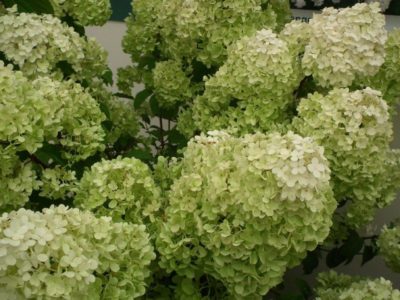
With regard to color, many gardeners make experiments, since this variety loves neutral or slightly acidic soil, it is difficult for the plant to tolerate alkaline soil. You can achieve the desired shade in the flowers of this plant by changing the acidity of the soil. Pink and almost crimson shades of inflorescences appear in slightly alkaline soil, but in acidic soil they can acquire a blue tint. Thus, in the presence of a highly alkaline environment in the soil, experts, in order to achieve blue or even lilac flowers, water the soil with solutions of iron salts. There are times when inflorescences of several tones appear on 1 bush at once: blue, pink and white.
Necessary care
It is worth noting that all varieties of this type are moisture-loving, respectively, and the place for planting hydrangeas must be chosen not arid and shaded. With all this, the place should be well lit by the sun's rays and ventilated, strong shade and dampness are not the best conditions. The soil, as mentioned above, should be rich in minerals, acids, salts and iron, but calcareous soil is destructive for it.
A plant in the wrong soil can take root, but it may never grow and bloom. This variety is also loved by flower growers for its frost resistance, the plant can withstand up to -15 ° C.
Planting
Planting of the material begins in early spring, the most favorable period is considered from the moment the soil thaws until the first buds appear on the trees. For planting, a hole is dug, the depth of which is about 50 cm, and the diameter is 40-50 cm.The distance from 1 hole to another should be calculated based on the variety, since an adult plant can reach more than a meter in width, then the distance should be no less ... It is necessary to add humus, peat and mineral fertilizers in equal parts to the pit.
When planting, the bush is placed in the center of the hole, and the roots are carefully straightened to the sides, giving them a further direction. Experts advise deepening the root collar by no more than 2-3 cm, otherwise growth may be slowed down, and the plant will need additional time to gain strength.When digging in a hole, it is worth tamping the soil well, so that voids do not form among the roots, this can lead to their drying out. Immediately after planting, the holes are well moistened, it is recommended to direct the stream of water to the center of the hole so that the soil shrinks, and, if necessary, add the earth immediately. Accordingly, almost immediately it is worth mulching the soil: wood chips, peat and bark are poured around the shrub with a layer of 7-10 cm.
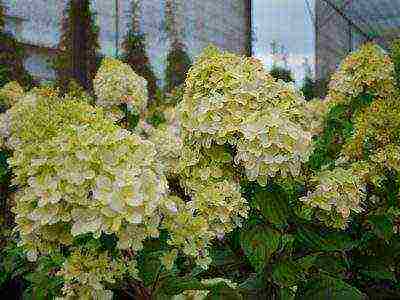
An important nuance is that this particular mulch composition is ideal for hydrangea; over time, this layer will turn into soil and significantly acidify it, which is so necessary for good plant growth. Adult plants are mulched in spring and autumn as needed. The autumn mulching procedure is carried out with the onset of stable frosts.
The basic rules for care are timely watering, fertilization and pruning of the bush. Each such event must be given a lot of time and carried out correctly, since the healthy growth and flowering of hydrangeas will depend on this. It is necessary to feed the plant several times per season. Fertilizers are recommended to choose a prolonged action. The shrub needs additional nutrition due to its abundant flowering. Lush inflorescences and tree-like stems require a lot of strength from the plant, and this is what depletes it. And additional feeding will allow the shrub to bloom and not stop growing. The first fertilization falls on the planting period, the second, at the stage of intensive growth, is carried out every 2 weeks, feeding is stopped at the end of July or August.
Pruning hydrangea Diamantino requires annual, the abundance of its flowering and the size of the inflorescences themselves depend on this. The pruning stage is performed in early spring until the buds appear on the branches. Cut off last year's branches into 2-3 buds, but at the end of summer, before the onset of cold weather, you can prune young branches into 3 or 5 buds. In the spring, experts carefully examine the bush and remove frozen and old branches. To rejuvenate the shrub, it is necessary to cut 1 of the old branches at the base of the plant every year. For the winter, shrubs are covered, although they are considered frost-resistant. For insulation, spruce branches are used or special materials that can be purchased in specialized stores.
Watering is carried out regularly. The plant loves moisture quite strongly, but excessive dampness can lead to root system disease. In dry weather, it is necessary to water the bushes at least 2-3 times a week. It is better to use water for irrigation that is settled and not cold. Watering is usually done in the morning before sunrise. It is necessary to try to direct the stream of water strictly into the hole and not get on the leaves and flowers, otherwise they may get burns with the appearance of sunlight. If the soil is mulched, then it will not be difficult to loosen it periodically, but open ground can crust and crack in dry weather, which should be avoided.
In general, the cultivation of Diamantino hydrangea is not difficult, the main thing is to fulfill all the requirements for care correctly and on time. And this oriental beauty will be able to decorate any garden, park area and landscape.
And a little about secrets ...
The story of one of our readers Irina Volodina:
I was especially depressed by the eyes, surrounded by large wrinkles plus dark circles and swelling. How to remove wrinkles and bags under the eyes completely? How to deal with swelling and redness? But nothing makes a person look older or younger than his eyes.
But how to rejuvenate them? Plastic surgery? Recognized - not less than 5 thousand dollars. Hardware procedures - photorejuvenation, gas-liquid pilling, radiolifting, laser facelift? Slightly more affordable - the course costs 1.5-2 thousand dollars. And when to find all this time? And it's still expensive. Especially now. Therefore, for myself, I chose a different way ...
>>
Homeowners try to create coziness and unique style. After all, it is important not only to grow vegetables and fruits. I would like to rest my soul and surround myself and my loved ones with beauty.
Flower arrangements are the basis of garden decor. Everyone has their own tastes and preferences. The hydrangea is considered the favorite of many gardeners.
Hydrangea is a deciduous shrub with gorgeous flowers. There are a huge number of varieties. Among the various varieties, panicle hydrangea "diamantino" prevails.
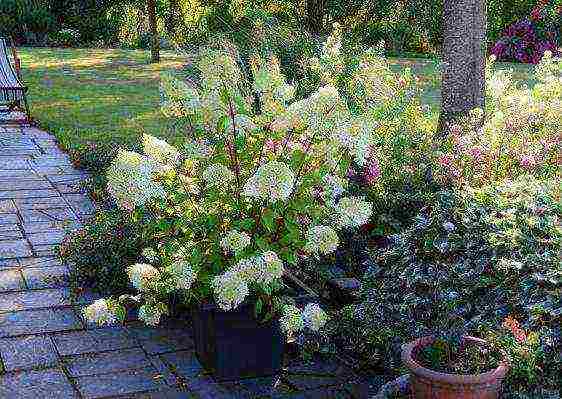
This gorgeous shrub will look great in a variety of compositions.
Botanical characteristics of hydrangea paniculata
The magnificent hydrangea "diamantino", the description of which can be continued endlessly, is a shrub abundantly covered with inflorescences. Reaches a little more than a meter in height. The crown has a rounded shape, slightly flared upwards.
The diameter of the flower is 23 cm on average. The inflorescence is visually similar to a panicle with dense and tightly adjacent flowers.
Hydrangea "diamantino" differs from other varieties in the paniculate shape of the inflorescence. The flower has a strongly rounded shape.
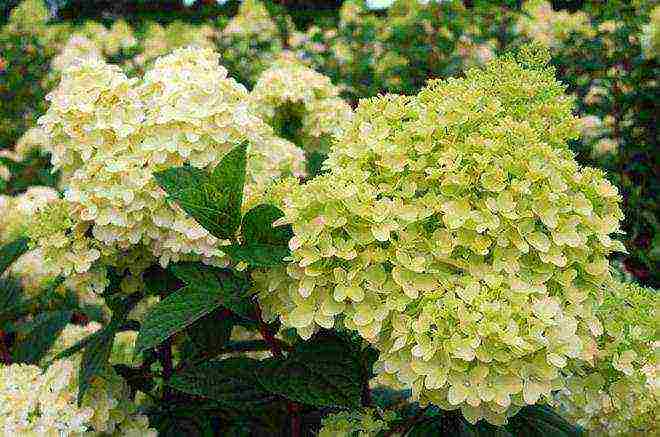
Flowers change shades more than once during the season. At the beginning of flowering, the color of the inflorescence is yellow with salad and golden tints. Then the flowers turn charmingly white. And by the end of their flowering they acquire a pale pink color.
Diamantino hydrangea blooms for a long period of time and is mostly abundant. Flowering begins in mid-June and ends in September. The shoots of the shrub are strong, so the plant does not require a garter. The leaves are dark green. Slightly rough to the touch.
Planting and leaving
First you need to decide on the landing site. It is advisable not only to take into account the design significance of the location, but also the illumination of the site. For panicle hydrangea, partial shade is the most ideal lighting.
After planting, water the plant abundantly. Watering hydrangea "diamantino" is generally of great importance. With a long drought, the inflorescences become small. The best flowering can be achieved with light pruning. Hydrangea is a winter-hardy plant, but it is better to cover young bushes at first.
Soil and fertilizers
Hydrangea "diamantino" prefers fertile, mostly moist soil. Peat or humus can be added before planting. The increased lime content in the soil will adversely affect the plant.
The hydrangea will respond to fertilization with gratitude. But don't get too carried away. Feeding is carried out in spring and late autumn. It is better to use fertilizers specially designed for this type of shrub.
Pruning and reproduction
Periodic pruning of the plant is recommended by experienced gardeners. It provokes the most abundant hydrangea flowering.
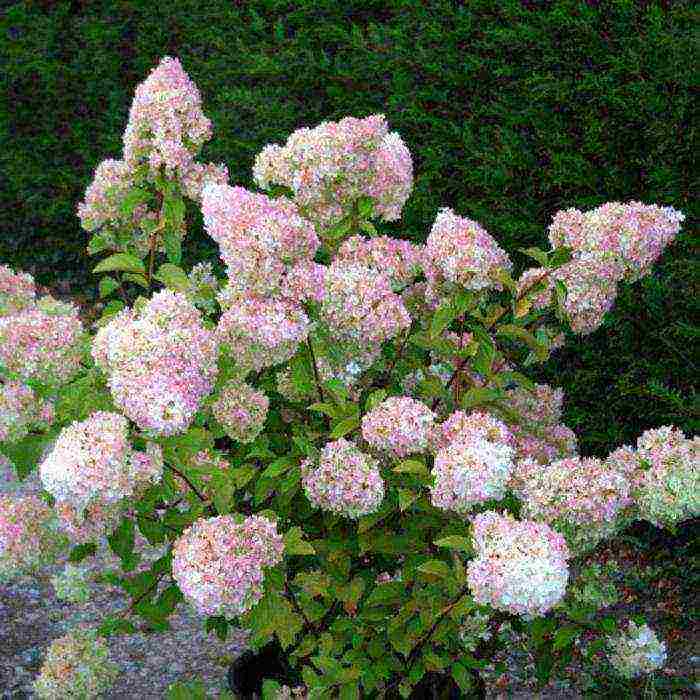
Once every 3 years, the hydrangea needs a major pruning. It is necessary to completely, at the root, remove dead and old branches. Pruning is best done in the spring. If the pruning technique is violated, some inflorescences may not bloom. It is recommended to leave 3-4 buds on a branch in autumn.
Hydrangea can be propagated in several ways:
- layering;
- cuttings;
- dividing the bush.
The last method is the easiest and most common. You can divide the bush both in spring and autumn. You need to dig it up and divide it into several parts. Each part is planted as an independent plant.
It is also easy to propagate hydrangea by layering. Young cuttings at the base are buried to the ground and fixed. The next year, the cuttings will give a root, and it can be transplanted.
Reproduction by cuttings is more complex. It is necessary to prepare cuttings in early spring. The cut is made at a right angle. Leaves are completely removed from below. The cuttings need to create greenhouse conditions until they are fully rooted.
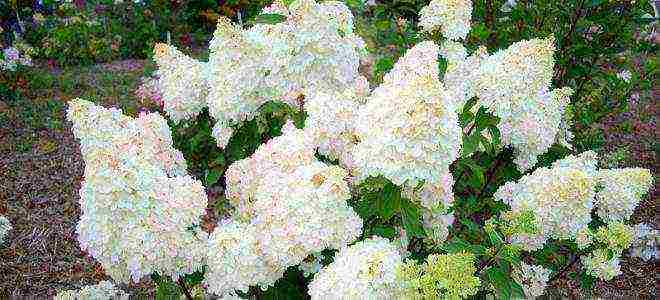
There are plant varieties that are cultivated with particular pleasure in all gardens.It is to these that the panicle hydrangea "Diamantino" is ranked. It stands out especially against the background of other varieties. When a summer resident plants a plant in his garden, it becomes a landscape design diamond.
Anyone who likes Diamantino hydrangea can achieve this. The description of the variety will tell you how best to plant, take care of the plant. A shrub that blooms beautifully deserves proper care.
Hydrangea "Diamantino" - description
The plant attracts attention with its vertical bush shape. The second reason why the shrub is chosen as a decor is abundant flowering. The plant reaches 120 cm in height and width.
The initial color of lush, dense inflorescences is yellowish green. Then it changes to white. At the end, the flowers turn pink. Their length is 20 cm. Compared to the inflorescences of other varieties, they are larger. Diamantino is suitable for growing in containers. Flowering begins in early to mid-July. Inflorescences wither in late August - early September.
Hydrangea "Diamantino" - planting and care
The variety has become popular because it can withstand frost well. Even twenty-degree frosts will not affect it. Fertile, slightly acidic soil is considered the best place to plant. With regard to illumination, partial shade is preferable. But the hydrangea also tolerates the sun well.
Preparation for planting begins with digging a hole. It should be 35-40 cm deep, 50 × 70 cm wide. If the hydrangea is planted next to other plants, leave a gap between them. The optimal distance will be from 1 to 3.5 m.
They take care of the variety like an ordinary plant. Fertilize, water, cut off old branches. There should be a lot of fertilizer so that large inflorescences remain beautiful. Pruning is done every year in early spring.
By taking proper care of the Diamantino hydrangea, you can beautify your plot with these beautiful flowers.
Hydrangea paniculata diamantino is a lush shrub with elongated inflorescences. Its blooms are plentiful and sometimes because of them you can't even see the big green foliage. Diamantino hydrangea reaches 2 m in width and height.
What is diamantino panicle hydrangea
Diamantino panicle hydrangea is one of the largest varieties of its kind. Its inflorescences have a pyramidal shape, the length of which is 20 cm. Their color over time can change from lime color to completely white. At the end of the flowering period, the hue changes back to pale pink.
The shrub blooms in early July, and the inflorescences begin to wither in September.
Coloring can also be experimented with by playing with the acidity of the soil. The more acidic the soil, the richer the blue color of the hydrangea will be, and if the soil is more alkaline, you can see raspberry inflorescences. To create magnificent compositions in one bush, you can grow inflorescences of several tones at once.
back to content ↑ Characteristics and care of the flower
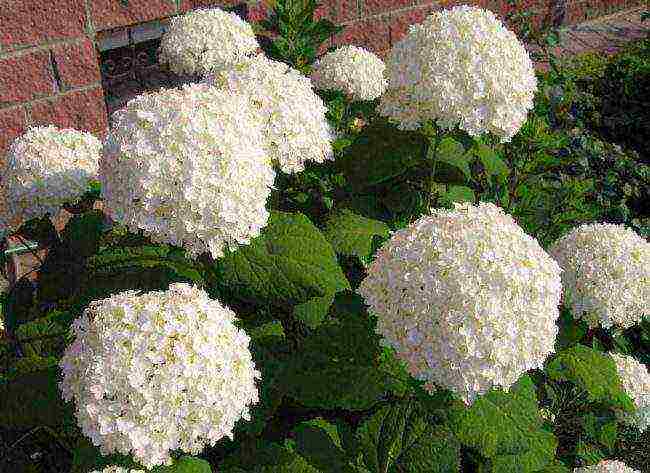 In caring for hydrangea, it is very important to choose a place that is not too dry and shaded for planting, since the plant is very moisture-loving. At the same time, the area should be well ventilated and sufficiently illuminated. Hydrangea does not tolerate strong shade and dampness.
In caring for hydrangea, it is very important to choose a place that is not too dry and shaded for planting, since the plant is very moisture-loving. At the same time, the area should be well ventilated and sufficiently illuminated. Hydrangea does not tolerate strong shade and dampness.
The soil should be rich in minerals, salts, acids and iron. Limestone soil, on the contrary, is detrimental to the diamantino hydrangea. The flower can take root even in the wrong soil, but its growth, development and flowering will be very slow or may not occur at all. Another advantage of the plant is its resistance to frost. The flower can withstand temperatures down to -15 ° C.
back to content ↑ Planting hydrangeas
The plant is planted in early spring. The best time is the period from the moment the soil thaws until the first buds appear on the trees. The depth of the planting hole should be at least 50 cm, and the diameter should be about 40 cm.The interval between planting pits must be determined based on the plant variety, since an adult shrub can grow up to 1 meter wide. Accordingly, the distance between plants should be no less. It is equally important to put a good layer of humus, peat and mineral fertilizers on the bottom of the pot or in the planting hole when planting.
In the process of planting, it is important to place the bush in the middle of the pot or hole, and direct the roots in different directions across the width, giving them a further direction.
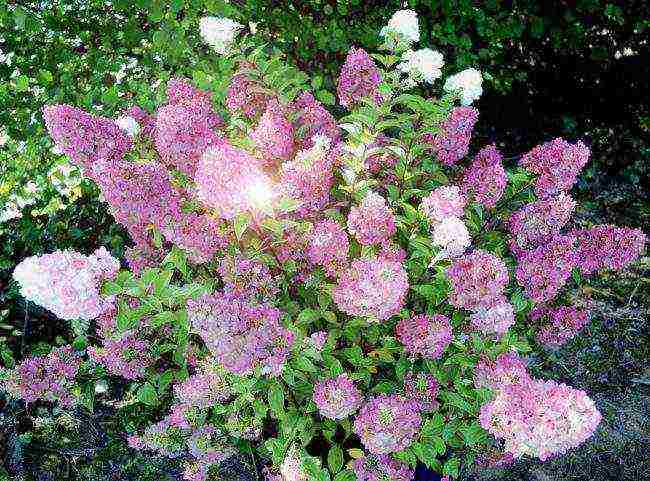 Experienced gardeners are advised to deepen the root collar by no more than 3 cm. Otherwise, growth will slow down, and then the plant will need a lot of time to recuperate.
Experienced gardeners are advised to deepen the root collar by no more than 3 cm. Otherwise, growth will slow down, and then the plant will need a lot of time to recuperate.
When planting, the soil should be well compacted so that there are no empty spaces between the roots, because of which the roots themselves may begin to dry out over time. Immediately after planting, it is recommended to thoroughly moisten the plant; it is better to direct the stream of water to the middle of the hole, so that the soil settles well, and then, if necessary, add the earth immediately. You can also mulch with wood chips, bark and peat. They need to be sprinkled around the shrub with a layer 7-10 cm thick.
back to content ↑ Pruning and watering a flower
Large-leaved hydrangea diamantino needs annual pruning, on which the success and size of its flowering depends, as well as the growth of the shrub itself. The best time for this procedure is early spring. It is better to prune before buds appear on the branches. It is recommended to shorten last year's branches by 2-3 buds. In the summer, you can carry out a more global pruning of young branches by 3-5 buds. In the spring, it will be better to remove frozen and old shoots.
There is also anti-aging pruning, which is based on the annual removal of one old branch at the base of the bush. Although the plant is quite frost-resistant, it still needs to be covered a little. To do this, you can use spruce branches or a special material that is sold in specialized stores.
Watering should be abundant and regular, but you should be careful with it, as overflowing the plant can lead to waterlogging of the soil.
Too wet soil, in turn, will affect the root system and lead to its rotting. When watering, it is also advisable not to get on the leaves and water it up to 2-3 times a week in hot or dry weather. Water for irrigation should be warm and settled.
Similar articles:


